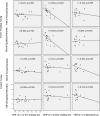Shifting Perceptual Weights in L2 Vowel Identification after Training
- PMID: 27649413
- PMCID: PMC5029867
- DOI: 10.1371/journal.pone.0162876
Shifting Perceptual Weights in L2 Vowel Identification after Training
Abstract
Difficulties with second-language vowel perception may be related to the significant challenges in using acoustic-phonetic cues. This study investigated the effects of perception training with duration-equalized vowels on native Chinese listeners' English vowel perception and their use of acoustic-phonetic cues. Seventeen native Chinese listeners were perceptually trained with duration-equalized English vowels, and another 17 native Chinese listeners watched English videos as a control group. Both groups were tested with English vowel identification and vowel formant discrimination before training, immediately after training, and three months later. The results showed that the training effect was greater for the vowel training group than for the control group, while both groups improved their English vowel identification and vowel formant discrimination after training. Moreover, duration-equalized vowel perception training significantly reduced listeners' reliance on duration cues and improved their use of spectral cues in identifying English vowels, but video-watching did not help. The results suggest that duration-equalized English vowel perception training may improve non-native listeners' English vowel perception by changing their perceptual weights of acoustic-phonetic cues.
Conflict of interest statement
The authors have declared that no competing interests exist.
Figures



Similar articles
-
English vowel identification and vowel formant discrimination by native Mandarin Chinese- and native English-speaking listeners: The effect of vowel duration dependence.Hear Res. 2016 Mar;333:58-65. doi: 10.1016/j.heares.2015.12.024. Epub 2016 Jan 6. Hear Res. 2016. PMID: 26768853
-
Distinctiveness and Assimilation in Vowel Perception in a Second Language.J Speech Lang Hear Res. 2019 Nov 20;62(12):4534-4543. doi: 10.1044/2019_JSLHR-H-19-0074. Print 2019 Dec 18. J Speech Lang Hear Res. 2019. PMID: 31747532
-
The effect of native vowel processing ability and frequency discrimination acuity on the phonetic training of English vowels for native speakers of Greek.J Acoust Soc Am. 2010 Dec;128(6):3757-68. doi: 10.1121/1.3506351. J Acoust Soc Am. 2010. PMID: 21218907
-
What Acoustic Studies Tell Us About Vowels in Developing and Disordered Speech.Am J Speech Lang Pathol. 2020 Aug 4;29(3):1749-1778. doi: 10.1044/2020_AJSLP-19-00178. Epub 2020 Jul 6. Am J Speech Lang Pathol. 2020. PMID: 32631070 Free PMC article. Review.
-
The Acoustic Features and Didactic Function of Foreigner-Directed Speech: A Scoping Review.J Speech Lang Hear Res. 2022 Aug 17;65(8):2896-2918. doi: 10.1044/2022_JSLHR-21-00609. Epub 2022 Aug 1. J Speech Lang Hear Res. 2022. PMID: 35914012
Cited by
-
The Role of Temporal Acoustic Exaggeration in High Variability Phonetic Training: A Behavioral and ERP Study.Front Psychol. 2019 May 24;10:1178. doi: 10.3389/fpsyg.2019.01178. eCollection 2019. Front Psychol. 2019. PMID: 31178795 Free PMC article.
References
-
- Goto H. Auditory perception by normal Japanese adults of the sounds “L” and “R”. Neuropsychologia. 1971; 9: 317–323. - PubMed
-
- Beddor PS, Strange W. Cross-language study of perception of the oral-nasal distinction. J Acoust Soc Amc.1982; 71: 1551–1561. - PubMed
-
- Gottfried TL. Effects of consonant context on the perception of French vowels. J Phon. 1984; 12: 91–114.
-
- MacKain KS, Best CT, Strange W. Categorical perception of English /r/ and /l/ by Japanese bilinguals. Appl Psycholinguist. 1981; 2: 369–390.
-
- Tao S, Mi L, Wang W, Dong Q, Liu C. Spectral and duration cues of English vowel identification for Chinese-native listeners. J Acoust Soc Amc. 2014; 136: 2106–2106.
Publication types
MeSH terms
LinkOut - more resources
Full Text Sources
Other Literature Sources

